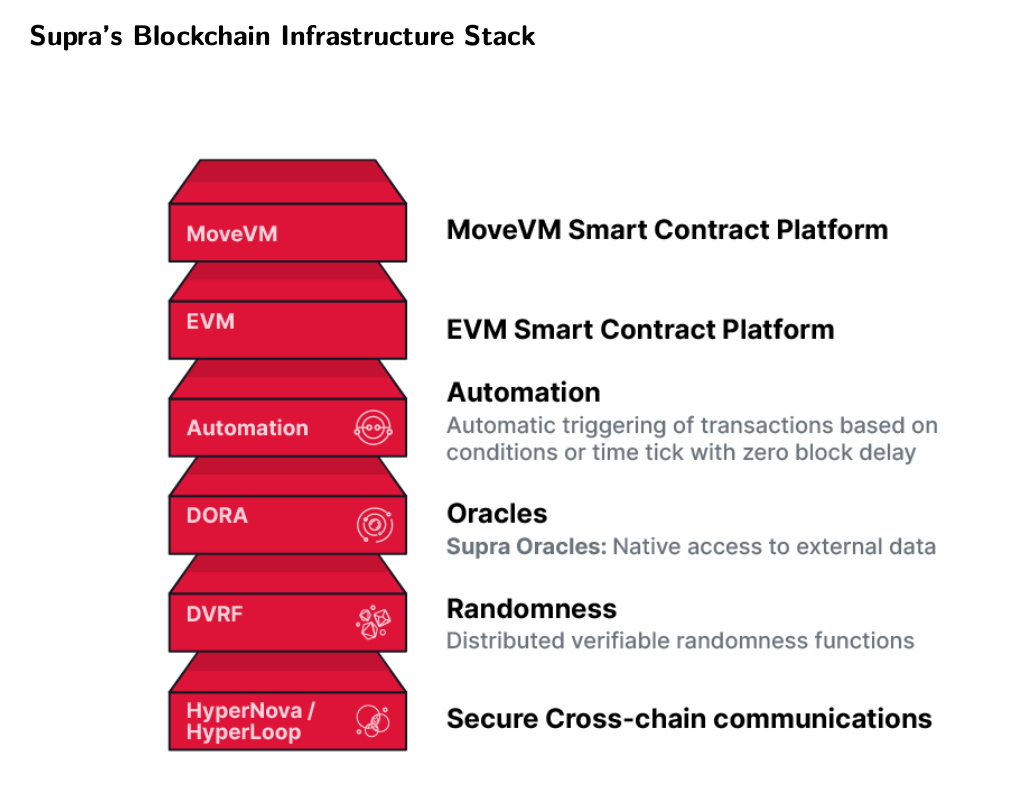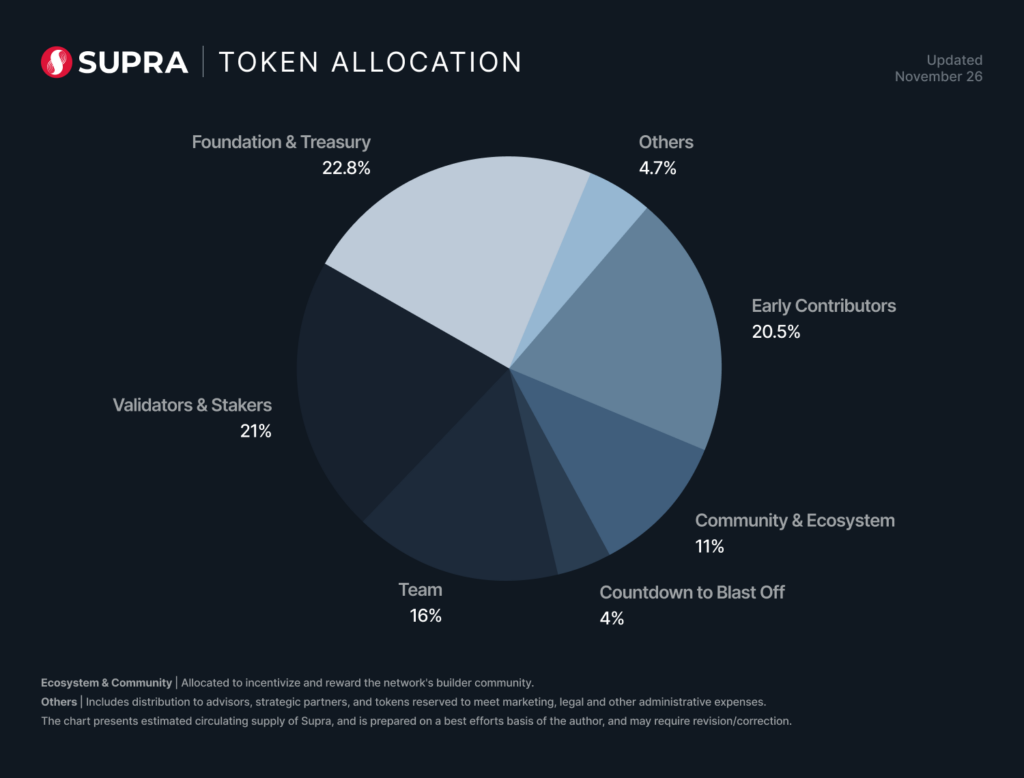Supra: Vertically Integrated Layer 1 Blockchain
Supra is a next-generation Layer 1 (L1) blockchain that leverages vertical integration to achieve extreme throughput and introduce an all-in-one stack of web3 services in a single ecosystem. Powered by its native SUPRA cryptocurrency, the L1 network seeks to introduce a one-stop solution that promotes interoperability, capital efficiency, sustainability and liquidity.
In this article, we’ll explore the Supra blockchain, its key features and components and the SUPRA cryptocurrency's tokenomics and utility.
Key Takeaways:
Supra is a next-generation Layer 1 blockchain with a full stack of native vertically integrated blockchain services.
With the Moonshot consensus mechanism and transaction parallelization, Supra can achieve extreme scalability with minimal latency.
The native SUPRA cryptocurrency powers the ecosystem, serving as a governance, gas and staking token.
What Is Supra?
Launched on Nov 27, 2024, Supra is a fully vertically integrated Layer 1 blockchain network compatible with multiple virtual machines (VMs). It’s an all-in-one blockchain with a complete ecosystem of native services, ranging from oracles and VMs to automation and cross-chain communication. With parallelization and the Moonshot consensus mechanism, Supra’s blockchain can scale up to 500,000 transactions per second (TPS), with finality in 600–900ms.
Supra's vertically integrated blockchain network is powered by the native SUPRA cryptocurrency. After its recent token generation event (TGE) on November 27, the digital asset is trading at $0.01071 (as of December 5, 2024), with a market cap of $63.99 million, a fully diluted value (FDV) of $1.08 billion and a $16.12 million trading volume over the past 24 hours. Currently, 6 billion SUPRA are in circulation out of a total supply of 100 billion tokens.
Key Features of Supra
Supra offers the following key features to cryptocurrency users and developers.
Full Native Vertical Integration: Supra's core value proposition is the full native vertical integration of blockchain services. As a one-stop solution, developers can access all required solutions without relying on external networks.
Enhanced Scalability and Speed: Supra can achieve 500,000 TPS with a finality of 600–900ms for a seamless user and developer experience.
Interoperability: With its HyperNova and Hyperloop cross-chain tools (see more below), Supra can connect seamlessly with other blockchains, facilitating asset bridging and cross-chain liquidity.
Dedicated DApp Space: Developers can create application-specific chains (appchains) via Supra Containers for flexibility, autonomy and shared security.
Modularity: Supra’s modular design allows DApp builders to upgrade components independently without disrupting the entire system. With its native vertical integration, Supra unifies all services under a single chain, with shared economic security and a unified token economy.
How Does Supra Work?
Supra addresses the challenges decentralized applications (DApps) encounter when relying on multiple networks for functionality. Doing so weakens the stack, leading to higher costs, broken security guarantees, increased complexity and added latency.
To provide an effective solution to this problem, Supra leverages a fully vertically integrated ecosystem of native blockchain services featuring the following key infrastructure components.
Multiple VMs: In addition to supporting numerous types of assets, Supra is also compatible with various Turing-complete smart contract execution environments, including the Ethereum virtual machine (EVM) and MoveVM. This enables developers to run their contracts from any ecosystem on the L1 blockchain.
Automation Services: Supra offers developers access to its native zero-block delay automation network. As a result, they can schedule transaction execution based on specific time ticks, as well as on-chain and off-chain events.
Blockchain Oracles: As part of a powerful cross-chain oracle network, Supra Oracles offers DApps fast, secure, scalable and decentralized data solutions. The L1 blockchain's native oracles are powered by the Distributed Oracle Agreement (DORA) protocol.
Distributed Verifiable Randomness: With Supra, developers have access to push and pull on-chain randomness services in order to generate and provide distributed verifiable randomness functions to both Web 2.0 and web3 users.
Cross-Chain Communications: Despite a whole stack of native blockchain services in its ecosystem, Supra can also communicate with other chains through HyperNova and HyperLoop. The former is a bridgeless relay protocol for simple event communication, facilitating cross-chain liquidity without additional risks. At the same time, HyperLoop is the L1 chain's bonded, pairwise cross-chain bridge that prevents double-spending for cross-chain transfers.
Parallel Execution: Supra can execute transactions in parallel, enhancing scalability and throughput without sacrificing decentralization. To achieve this, the network is organized into subcommittees of nodes called Clans. Each Clan functions independently, handling a portion of transactions and enabling multiple batches to be processed simultaneously.
Containers: Each Clan in Supra's network can have either multiple Containers (groups of smart contracts related to a single DApp), or a group of related DApps. In addition to fostering parallelization, Containers offer dedicated, customizable space for DApps. These appchains reside directly on Supra's mainnet, providing the flexibility of Layer 2 (L2) chains.
Supra Consensus Mechanism: Commit Moonshot
A unique component of Supra's infrastructure is the L1 blockchain's Commit Moonshot consensus mechanism. As an extension of Chained Moonshot, the algorithm is a rotating leader–based protocol that provides every validator an equal chance of being elected for block propositions.
What makes Commit Moonshot unique is that it allows the next leader to propose their own block as soon as it votes for its predecessor's proposal. This significantly increases efficiency for a more scalable design than that of most consensus mechanisms within the crypto market. In fact, Moonshot can produce blocks at network speed and achieve finality in only three messages between nodes.
SUPRA Token Utility and Tokenomics
The native SUPRA cryptocurrency functions as both a utility and governance token in Supra's ecosystem, fulfilling the following use cases.
Staking: Validators stake SUPRA to propose blocks, earning staking rewards in exchange for securing the blockchain.
Gas Fees: SUPRA also serves as a gas fee token. Ecosystem participants use the cryptocurrency to cover the gas fees of their transactions, which can range from simple balance transfers to the deployment of smart contracts.
Governance: Holders can use the SUPRA token to propose and vote on changes related to the blockchain network's future, as part of Supra's community governance mechanism.
SUPRA has a maximum supply cap of 100 billion tokens, with 6 billion currently circulating. The coin’s distribution model is illustrated below:
Conclusion: Trade SUPRA on Bybit Now
With a full stack of vertically integrated native blockchain services, Supra’s L1 blockchain promotes capital efficiency, scalability, flexibility and long-term sustainability. Instead of relying on external networks, DApps can leverage Supra's modular design and all-in-one chain to access the solutions they need within a single ecosystem. Supra is powered by its native SUPRA crypto token, which fulfills the key use cases of staking, governance and gas fee payments.
With Supra's TGE now complete, you can trade the SUPRA token on Bybit Spot, the intuitive and user-friendly trading platform. Head to Bybit to get started!
#LearnWithBybit




